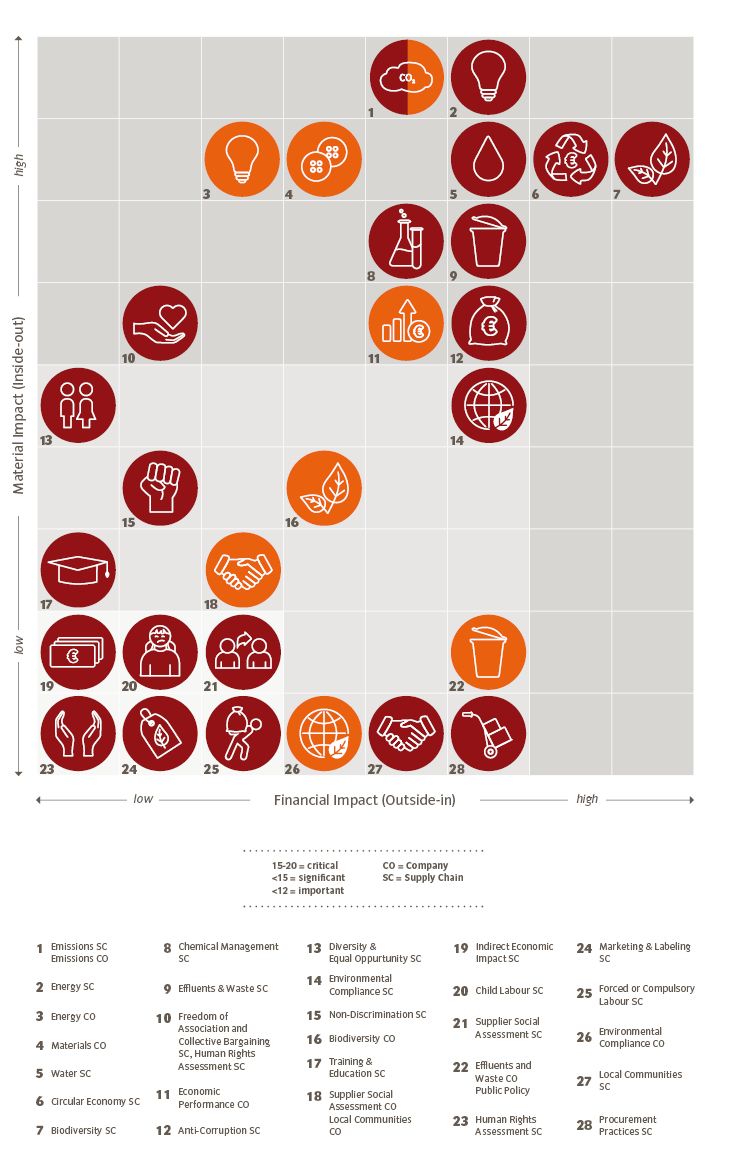
Our mission: fact-based, transparent reporting on all major sustainability issues
A new process for determining materiality
This report contains relevant information on issues during the reporting period (fiscal year 2022 and an outlook on effects and issues of future material aspects
We have begun to align our materiality analysis with the requirements of the European Sustainability Reporting Standards (ESRS) for this report, even though it is still in the draft stage. More information can be found here.
To date, we have evaluated our content based on the following two criteria:
- Influence on stakeholder assessments and decisions.
- Significance of economic, environmental, and social impacts.
The central element of the planned ESRS materiality analysis is Dual Materiality. This approach assesses the topics from two perspectives:
- Impact Materiality (Inside-out perspective): What impact do our business activities have on people and the environment? (Inside-out perspective).
- Financial Materiality (Outside-in perspective): How do sustainability issues influence our business activities? What are the financial impacts, opportunities, and risks for the company? (Outside-in perspective).
The basis for our list of topics that we assessed for materiality in 2022 is the list of aspects provided by GRI.
Selection based on the list of all GRI Aspects
In order to create a complete report, we began our process of materiality by looking at the complete list of GRI Aspects. GRI Guidelines are divided into categories; each category is then divided into aspects. Within each aspect, there are several indicators that describe the economic, environmental and social performance of a company. In the next report, the issues from the ESRS standard will form the basis for the materiality analysis.
Material aspects determined by the team
The material aspects of this report were identified in a company-wide report team. Team members are employees in key positions who are concerned with sustainability issues and have contact with our stakeholder groups (e.g. human resources, environmental management officer, sustainability communicators, product line implementation).
VAUDE materiality matrix

Point system for evaluating materiality
We evaluated the issues as follows:
1. Impact Materiality (inside-out): What impact do our business activities have on people and the environment?
For each aspect, we assessed:
- Is the impact positive or negative?
- Is it potential or actual?
- What is the likelihood of occurrence?
- How severe or beneficial is the impact (magnitude)?
- How significant are the effects? How many people are affected?
- Only for negative impacts: Can the effects be mitigated?
The likelihood of occurrence, significance, magnitude, and remediability were rated on a scale of 0 - 5.
Based on this, the issues were categorized as follows:
- 15 - 20 = critical
- < 15 = significant
- < 12 = important
- 5 - 8 = medium
- < 5 = minimal (not significant)
2. Financial Materiality (outside-in): How do sustainability issues influence our business activities? What are the financial impacts, opportunities, and risks for the company?
For each aspect, we evaluated:
- Whether we can continue to use resources in the short, medium, or long term and how costly it would be for us.
- The current state of our relationships with business partners or stakeholders and how they are expected to develop in the future.
Each aspect was rated on a scale of 0-4. This resulted in the following categorization:
- > 6 = critical
- > 4 = significant
- < 2 = important
- > 2 = minimal (not significant)
- 0 = neutral
To identify sustainability-related risks and opportunities that have or could have financial impacts, we made an initial assessment and collected topics based on expert experiences this year. This part of the materiality analysis will be further developed over the next two years to meet the information requirements of the ESRS.
Only aspects that fell below the materiality threshold in both areas will not be reported. This applies only to the following aspects in this reporting year:
- Non-discrimination (at the site), Water (at the site)
The following aspects were only evaluated for the supply chain as they are not relevant at the company's location:
- Forced labor, Child labor, Freedom of Association and Collective Bargaining in the Supply Chain, Anti-Corruption
Newly added aspects:
- Anti-Corruption, Circular Economy
The following aspects were not evaluated as they are not relevant to our company and/or industry:
- Security Practices, Rights of Indigenous Peoples, Anti-Competitive Behavior
The assessments are largely based on the experience of those responsible and on the discussion in the group as well as on feedback from stakeholders. We have verified individual aspects using figures, for example the expenditure on local suppliers. For each aspect, we also assessed whether the impacts occur within the company, or upstream or downstream in the value chain.
Subsequently, the result was discussed and approved with the management, which also includes Jan Lorch (Managing Director Sales and CSR).
The results of our materiality analysis can be found here.
Comparing material aspects with company goals
We have aligned the aspects identified as material with our corporate goals - see "Our Goals in Detail". This ensures that the direct link with the company's strategy is visible. We report which targets we have already achieved in the past year and which we are still working to improve.
| GRI: | 102-45 |
| GRI: | 102-46 |
| GRI: | 102-47 |




